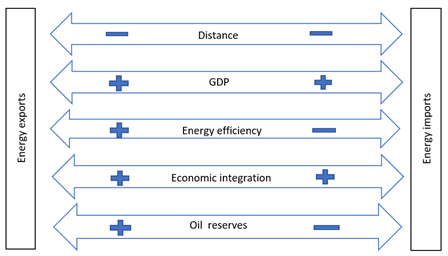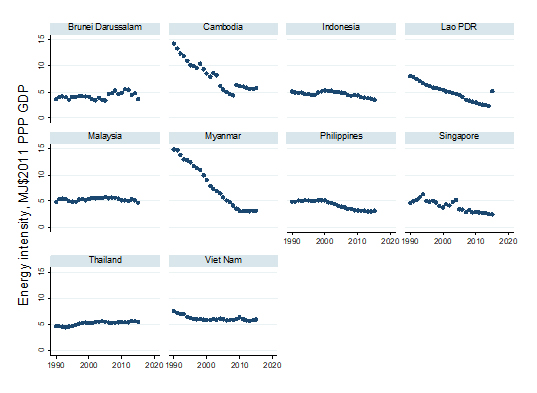 The security of energy supply is crucial for rapid growth in Southeast Asia, but it is being increasingly challenged by the region’s fast-growing energy demand. This high demand can be explained by improvements in energy access as well as population and economic growth. The Association of Southeast Asian Nations (ASEAN) is the sixth-largest economy in the world, the third-largest economy in Asia (after the People’s Republic of China (PRC) and Japan), and the third-largest market in the world (after India and the PRC), and it is projected to be the fourth-largest economy in the world by 2030. Since 2000, energy demand in ASEAN has grown by more than 80%, and it is projected that 12% of global energy demand growth will come from Southeast Asia by 2040 (IEA 2019).
The security of energy supply is crucial for rapid growth in Southeast Asia, but it is being increasingly challenged by the region’s fast-growing energy demand. This high demand can be explained by improvements in energy access as well as population and economic growth. The Association of Southeast Asian Nations (ASEAN) is the sixth-largest economy in the world, the third-largest economy in Asia (after the People’s Republic of China (PRC) and Japan), and the third-largest market in the world (after India and the PRC), and it is projected to be the fourth-largest economy in the world by 2030. Since 2000, energy demand in ASEAN has grown by more than 80%, and it is projected that 12% of global energy demand growth will come from Southeast Asia by 2040 (IEA 2019).
Currently, ASEAN as a whole is a net exporter of energy, with six of its 10 member states being net energy exporters. However, with depleting resources and growing energy demand, ASEAN is likely to change from being a net exporter of energy to becoming an importer. Renewable energy in ASEAN is produced mostly from solid biomass, such as firewood and wood chips used for cooking, while renewable energy generation using advanced technologies is low. For example, geothermal energy comprises 6% of generation while hydro power comprises 3% of generation in ASEAN (Liu, Sheng, and Azhgaliyeva 2019a, 2019b). Thus, international energy trade is crucial for energy security in the region.
Classical trade theory suggests that trade between two countries is closely correlated with the distance between them. Although ASEAN member countries have lower energy transportation costs due to the smaller distances between them, their trade in energy is mostly with non-ASEAN countries. The top importers of energy from ASEAN are Japan; the People’s Republic of China (PRC); Australia; the Republic of Korea; Hong Kong, China; India; Taipei,China; the United States; and Bangladesh. Meanwhile, the top exporters of energy to ASEAN are the United Arab Emirates; Saudi Arabia; the Republic of Korea; Qatar; Taipei,China; Kuwait; the PRC; India; Australia; and Oman (Liu, Sheng, and Azhgaliyeva 2019a, 2019b). Thus, distance may not explain the energy trade activities of ASEAN countries since energy trade is conducted mainly with countries from outside rather than within ASEAN.
To study the determinants of energy trade, Liu, Sheng, and Azhgaliyeva (2019a, 2019b) use the gravity model (Tinbergen 1962), a model commonly used for studying trade flows. The use of “gravity” in the model’s name is an analogy for the gravity equation in the study of physics. The model provides empirical evidence that international trade is proportional to the product of gross domestic product (GDP), geographical distance, and the presence of common borders or cultural similarities. Instead of studying the determinants of total trade in all goods, Liu, Sheng, and Azhgaliyeva (2019a, 2019b) study the determinants of energy trade. Apart from the determinants predicted by the gravity model, energy trade is shown to also be affected by the energy efficiency, renewable energy generation, and fossil fuel reserves of the trading countries.
Liu, Sheng, and Azhgaliyeva (2019a, 2019b) use annual data on bilateral trade between 440 countries over a 22-year period from 1995 to 2016 for three commonly traded energy sources—coal, natural gas, and crude oil. Overall, the sample consists of 162,943 observations. The data were collected from the United Nations Conference on Trade and Development, World Bank, International Energy Agency, and Energy International Association.
The study’s empirical estimation provides results that are mostly consistent with the existing literature (see Figure 1). Greater geographical distance between countries reduces international bilateral energy trade. This can be explained by transportation costs. In addition, energy trade is proportional to the size of the economies, measured by GDP. This means that larger economies, i.e., those with a larger GDP, have greater energy trade. The empirical results show that countries with greater energy efficiency export more energy and import less energy. Thus, energy efficiency improves the ability of countries to export energy and reduces the need to import energy.
The impact of energy efficiency on energy trade is very similar to the impact of fossil fuel reserves. For example, countries with more fossil fuel reserves export more energy and import less energy. Energy intensity across ASEAN members is shown in Figure 2. Regional integration can lead to more bilateral trade in energy products. Countries that are regionally integrated tend to trade more energy products than countries outside of a grouping.
Figure 1. Determinants of Energy Trade

GDP = gross domestic product.
Source: Author.
Figure 2. Energy Intensity in ASEAN Countries

Lao PDR = Lao People’s Democratic Republic.
Source: Author, using data from the World Bank’s Energy For All database.
The crucial contribution of this study is that it provides empirical evidence, based on a solid methodology and a substantial sample size, that improvements in energy efficiency reduce the need to import energy and improve the ability to export energy, thus improving energy security. Also, the energy trade of ASEAN member countries benefits from regional economic integration across ASEAN.
Due to the fast-growing energy demand among ASEAN member countries, policy changes to improve energy security are needed. The following policy recommendations could help improve energy security based on the empirical results by Liu, Sheng, and Azhgaliyeva (2019a, 2019b):
- Energy efficiency improves energy security by reducing energy imports and increasing energy exports. This impact is similar to that of fossil fuel reserves. Thus, improving energy efficiency for energy security can be considered the same as increasing local reserves of energy.
- Energy trade across ASEAN members can be improved through stronger economic integration among ASEAN member countries.
Read the working paper here.
_____
References:
International Energy Agency (IEA). 2019. Southeast Asia Energy Outlook 2019. Paris: IEA.
Liu, Y., Z. Sheng, and D. Azhgaliyeva. 2019a. Toward Energy Security in ASEAN: Impacts of Regional Integration, Renewables and Energy Efficiency. ADBI Working Paper 1041. Tokyo: ADBI.
Liu, Y., Z. Sheng, and D. Azhgaliyeva. 2019b. Toward Energy Security in ASEAN: Impact of Regional Integration, Renewables, and Energy Efficiency. In Achieving Energy Security in Asia: Diversification, Integration and Policy Implications, edited by F. Taghizadeh-Hesary, N. Yoshino, Y. H. Chang, and A. Rillo. Singapore: World Scientific: 291–318.
Tinbergen, J. J. 1962. Shaping the World Economy: Suggestions for an International Economic Policy. New York: Twentieth Century Fund.







Comments are closed.